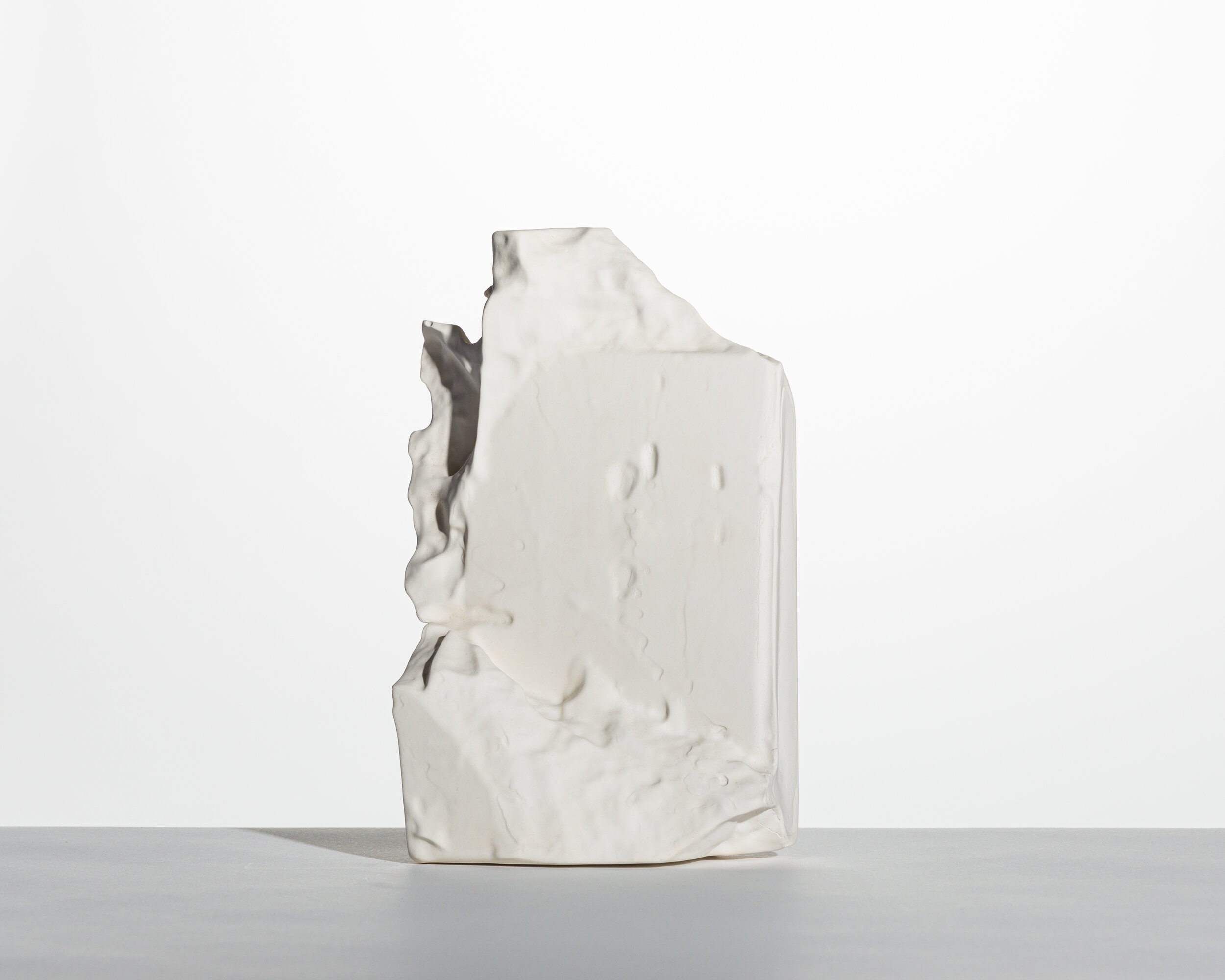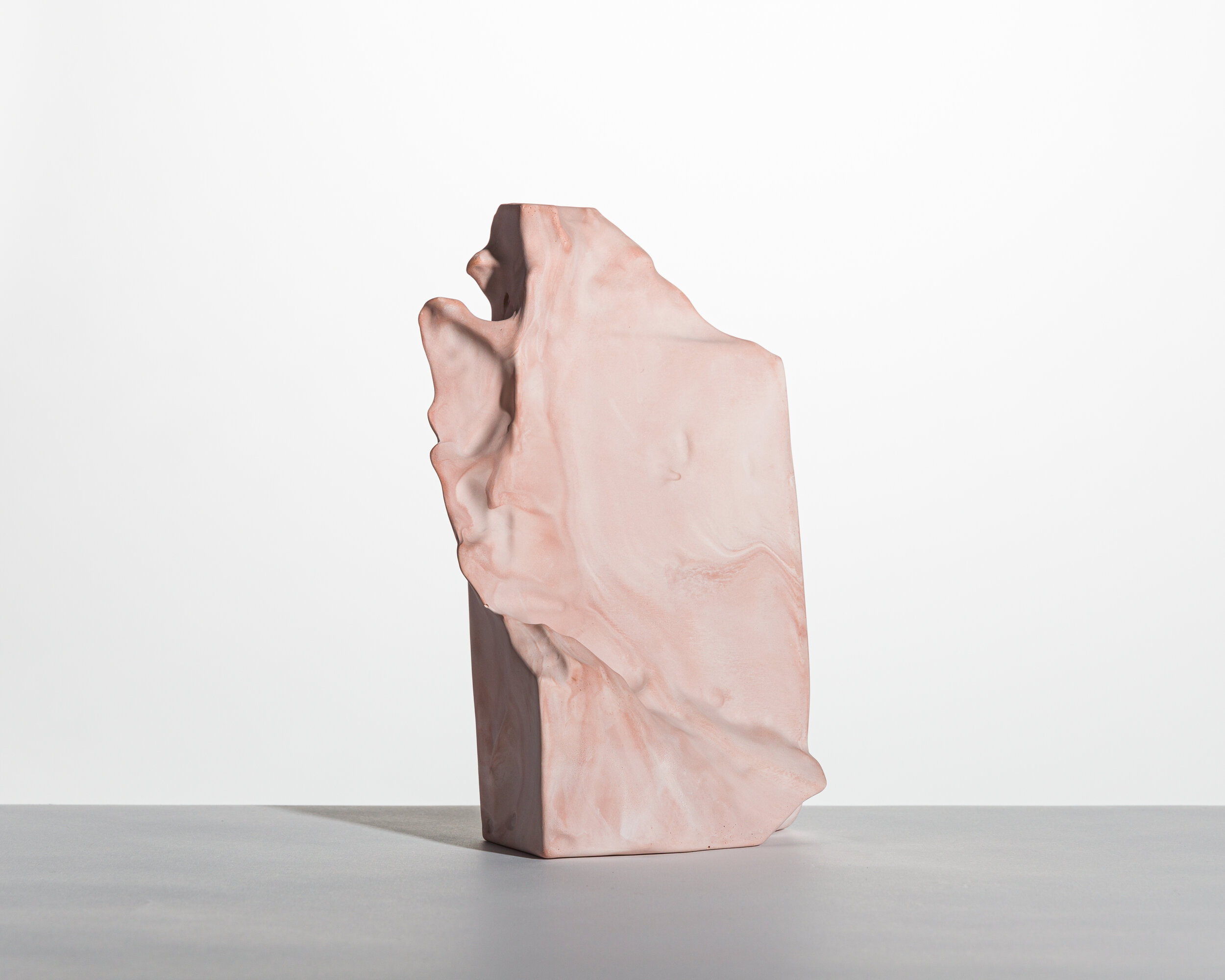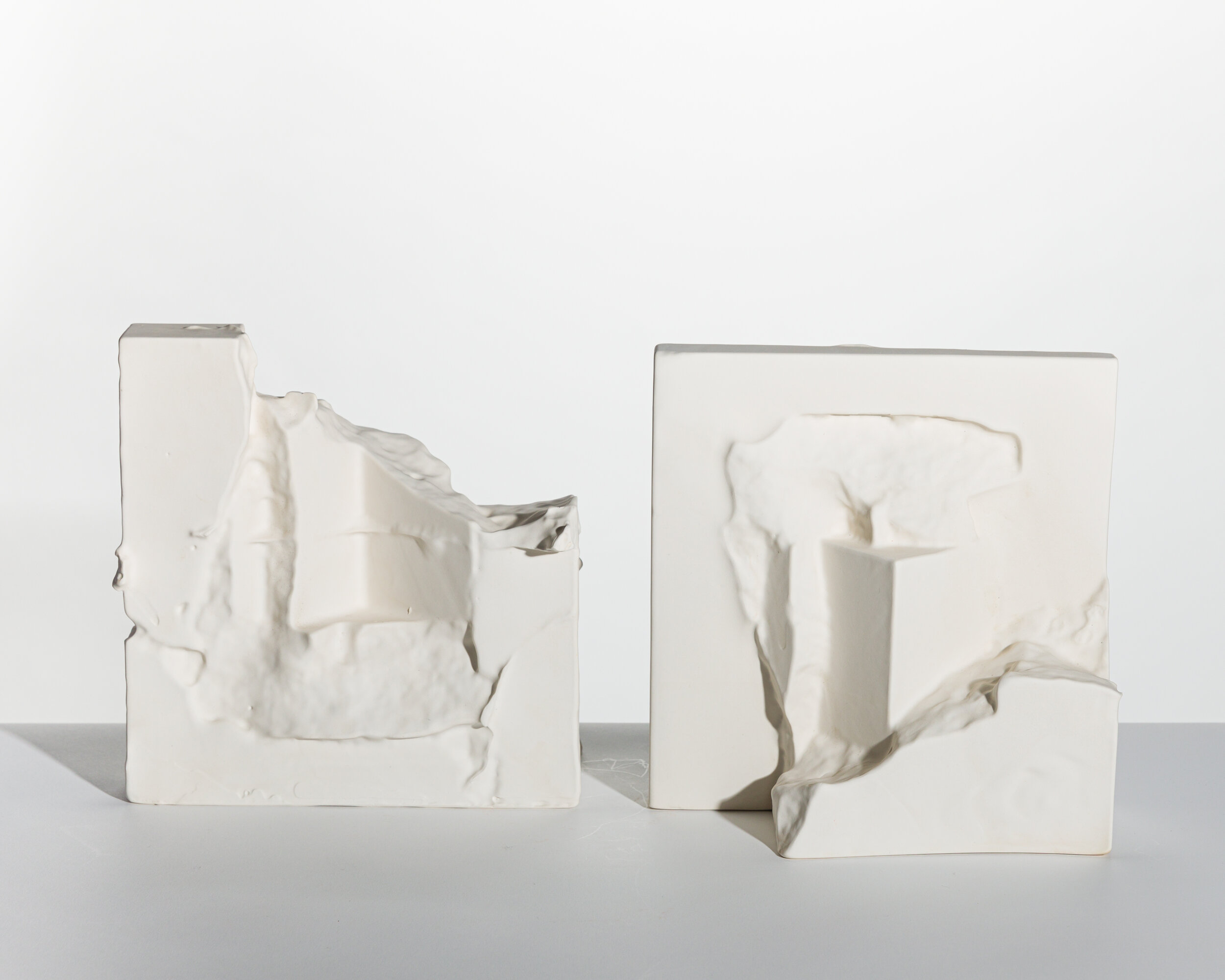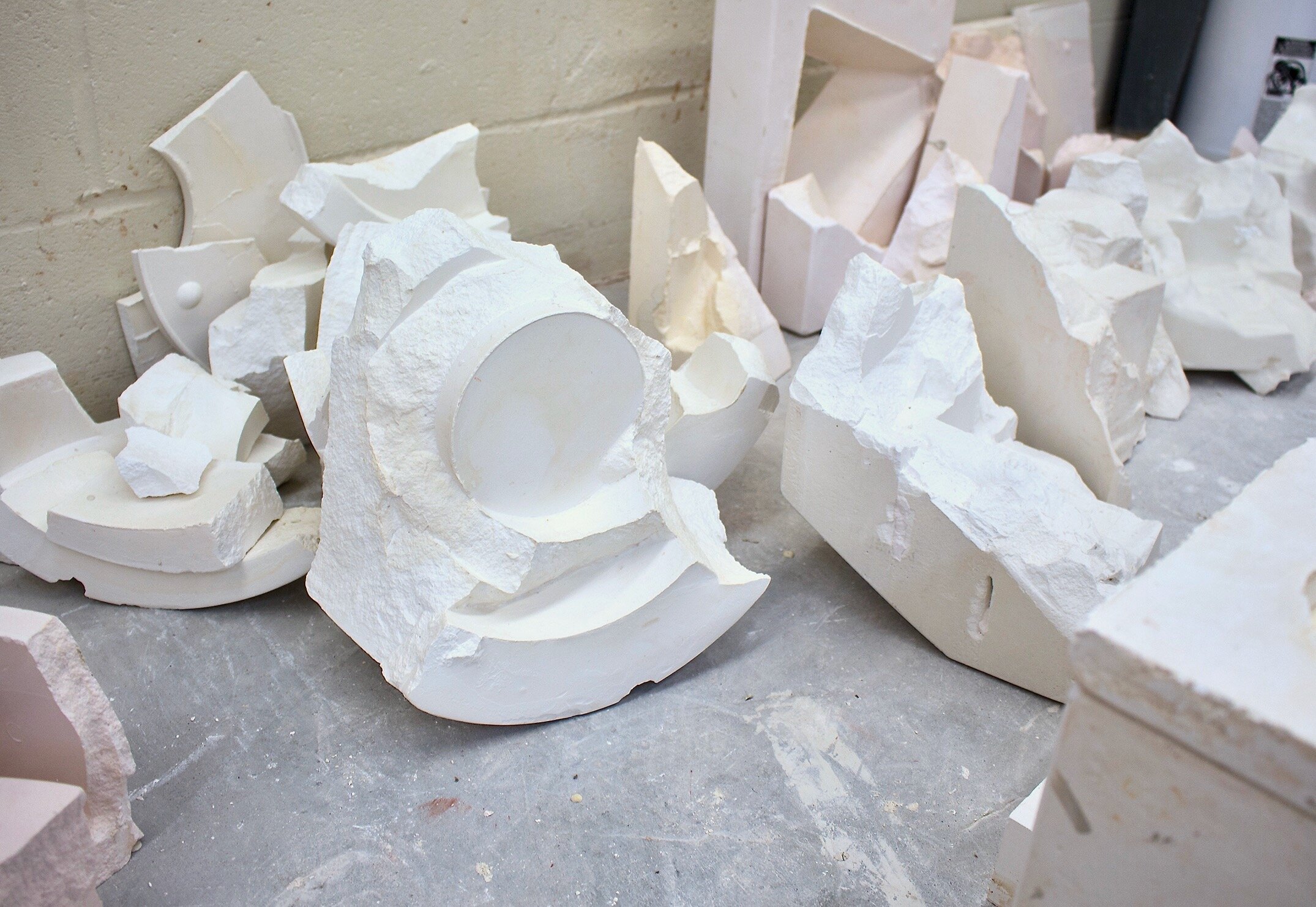Artist at her new home-studio in Baltimore, 2020
Hae Won Sohn
Hae Won (first name) Sohn (last name) is a visual artist and sculptor currently based in Baltimore, Maryland. Coming from Seoul, South Korea; Sohn earned her Bachelor of Fine Arts degree in Ceramics from the College of Design at Kookmin University and her Master of Fine Arts degree from the Ceramics Department at the Cranbrook Academy of Art, Bloomfield Hills, MI.
Statement:
My work is an active research of building extractive forms; furthermore, a nonlinear narrative study that develops dimensions, fragility, and aggregation through hand made processes. Its repetition is an act based on curiosity, of multitude and of habit while the approach is outwards, whimsical and rhizomatic. Using mold-making processes and techniques, these objects propose a methodology that enjoys invention in transition. Forms, often presented in series, become evidence of the making process. They resemble the past and the future but are unlike both. In this continuous form-finding, I tend to build relationships between new origins, thoughts, and contradictions.
Objects I create are casts of fragmented molds or exaggerated abstractions of the same. Molds—historically used to as voids—transform their behavior to now an engaged cast. Here, the residues, leftovers, remains, and remnants, which were once valuable parts in the context of one process no longer holds the same ideas, function, nor value once they are removed from its process. I celebrate these autonomous outcasts through the act of casting; which for me is an act of acknowledging individual, overseen, and marginalized history and its disappearance by preserving meaningful parts. These outcasts are exhaustedly performed in repetition to create layers that grow in volumes, masses, and spaces; becoming ambiguous exaggerations and self-representation of self. The environments of making inevitably become a resource for further exploration. In this habitat, all objects are artifacts of investigation. Importantly, its a physical documentation that viewers witness through the study in each piece as a beholder of another.
Interview with Hae Won Sohn
Questions by Andreana Donahue
Can you tell us a bit about your background and where you grew up? In what ways have your early visual experiences and personal history led to art-making?
My grandfather by nature, was a maker and craftsman who worked as a government employee at a municipal office in northern South Korea. During my formative years, I remember spending time simply sitting next to him (maybe sometimes “helping” him whatever that meant as a kid) while he made Gochujang (Korean red chili paste) from scratch. After buying a whole bunch of red chilis from the market, he would dry it out under direct sunlight outside from his basement apartment where my grandparents lived. After bringing the dried chilis back in, he would hand-grind them into fine flakes and after a few mysterious steps, in front of me there would be a batch of smooth, luscious, and dazzlingly red home-made Gochujang. I was often engaged in this process with all my senses except taste, as I assume it would’ve been too spicy for even a Korean kid to taste without tearing one’s eyes out. He also taught me special tricks in play ing Gong-gi (a Korean game similar to Jackstone), made sugar-cube-shaped rice cakes for the whole family to snack on, and would beautifully fold potato chip bags into tiny origami forms as a way of thriftily minimizing the volume of house-hold garbage. I believe it were these daily observations and engagements that influenced me to find excitement in creative (or sometimes destructive) projects. For instance as a toddler and a kid, I used to have my parents freak out by chopping off fringe bangs as a self-hair cut, and drawing on my two aunt’s notebooks who were also serious doodlers gifted by their father who’s also my dear grandfather.
My life since a kid was all about art, but it wasn’t until college that I got into the arts. I had no family members that I am aware of who were professionally involved in the visual arts, and it wasn’t until when I had to apply for college when I was given the option of considering art-making as a profession. My father was first to suggest the option of applying to an art program for college, since he has always been passionate about me and my sister’s education while being well aware of my interest in art. But he was also well aware of my lack of interest in studying other subjects in school which in Korea’s educational system were required in order to finding one’s way in getting into well known universities and colleges. By saying so, I naturally confess that I have not had fully pure intentions in my purpose for attending an art program, in the sense that it was partially a strategic way of hopping onto the train of higher education as a Korean born in a middle-class family. I am lucky enough for the fact that I actually ended up finding genuine joy and motivation from the ride continuing until today—now as the conductor rather than the last minute passenger I was in starting the journey of pursuing art as a liberating life style and sincere profession.
Untitled (grene), 2019. Hydrocal, oxide pigments. Photo by: Yassine El Mansouri.
Where are you currently based and what initially attracted you to working in this community? Are there any aspects of this place that have surfaced in your work?
I am currently based in Baltimore City, while (pre-pandemic) frequently traveling to New York and Washington DC for work and love for the cities. Initially I was brought to Baltimore to start a new position as a Long-term Resident Artist at Baltimore Clayworks, an organization centered in ceramic art/education. As it is the case for everywhere I end up as part of my artistic career, Baltimore is having me pleasantly linger for all the personal connections I have been able to make through art. As a an individual who returned to the States as an international student, friends become families and these new families builds a sense of home out of places that initially quite the opposite from “home.” My work doesn’t necessarily take any direct inspirations from external aspects. So no, I would not say my work conceptually nor visually embraces aspects of the “city” I am currently based in. My inspirations are mostly, if not entirely, derived from being physi cally present in my studio, which to me is a parallel universe and alternate reality where material generates ideas, evolves as artifacts, and builds system.
Can you tell us about your studio and what a typical day is like for you? Do you share space or ideas with other artists while working, or is it a more solitary routine?
My typical day in fact should be called typical night (or typical evening by the least) meaning I inconsistently live by a nocturnal schedule. This apparently is a life style that’s not necessarily healthy nor sustainable since in both an existential and professional sense since I happen to (un)intentionally avoid the world and its events. But un fortunately, this I think is the attraction for my tendency to start the day late—being able to work in the studio when left alone and engaging with the world in indirect ways. These days I start off the “day” with a good heavy meal, then I slowly start taking care of responsibilities, return home late and rest/take care of non-studio responsibilities, and eventually going to bed a couple hours before the birds start singing as part of their morning routine.
My practice is definitely more of a solitary routine, but meanwhile I am lucky to have a few people in my life—regardless of how “art” takes place in their lives—with whom I happily share ideas, from whom I actively seek advice/feedback, and to whom I can comfortably be miserable.
What criteria do you follow for selecting materials? Do you prefer to maintain a narrow focus or work across diverse media? How do you navigate the limitations and possibilities that result from this path?
I believe in searching for purpose in service of material, less than I believe in searching for material in service of purpose. The materials that currently occupies my practice—plaster, clay, and ceramics—was introduced to and selected by myself pretty much or organically and coincidentally. Without having any prior experience of working in clay be sides participating as a kid in a couple of ceramic try-out sessions, I readily chose to major in Ceramics when I was submitting my application for college. Thinking back, it was partially instinct and partially the romanticism portrayed in the (South Korean) media which made me wanted to explore and engage with clay. My exploration of plaster as main medium occurred quite naturally as well since I have learned and took slip-cast ing and plaster mold-making as a primary technique within my process. Although for a long time plaster existed as a secondary/behind-the-scene medium until I started to explore plaster the way I have been exploring clay. Therefore the hierarchy between the two has shifted; plaster is taking the spotlight while clay is working hard behind the scene.
My concept is closely tied to process and the “failures” that occur within. Kottie Gaydos, a Baltimore-based interdisciplinary artist who often works with photography and the photographic process, once provided effortless insight to me over a casual brunch by saying that I “take failure and turn it into a model(or system) of success.” Although this may not be her exact wording, I often revisit the moment of when she made such penetrating statement. I cannot find a better way to put in words of how I approach limitations, for to me, limitation is a synonym to a new possibility as how failure leads to a new model of success. Therefore I can’t say that I have ever felt “limited” by working with few sets of materials as failure barely ever fails to occur in such a craft-based and hands-on process.
Untitled (bleus), 2019. Porcelain, ceramic pigment. Photo by: Yassine El Mansouri.
Can you walk us through your overall process? How would you describe your approach to manipulating materials? What about decision-making and editing?
I in fact, deliberately try NOT to manipulate material but rather stay observant and acceptive towards how it (un)expectedly reacts, manifests, and performs. I often think of myself functioning as a catalyst between the material and object it happens to become. For the past couple of years, I have been concurrently developing two visually distinct bodies of work. While both the process and objects of each revolve around and evolve from the slip-casting and plaster mold-making technique, one takes more of a graphical approach where as the other focuses on process itself as a concept and visual and physical element in form-finding. I intentionally break-open my plaster molds, select certain broken pieces to combine it with its prototype, and repeat the same steps until the form becomes something of its own rather than a combination of many. These forms, often presented as series, become the evidence of my process and proposes a methodology that enjoys invention in transition.
Can you talk about some of the ongoing interests, imagery, and concepts that have informed your process and body of work over time? How do you anticipate your work progressing in the future?
During my time as a graduate student, especially during the very first year, I struggled immensely under the pressure of feeling the need to be experimental for the sake of be ing experimental while taking a superficial approach to the meaning of “experiment.” I realized after going back and forth between different medium and subjects to explore, that innovation and meaningful experimentation—especially within a material-centric field or art-making—happens when one stretches their current material and process until its maximum capacity that one naturally feels the urge to break out, expand or move on. This realization—that exploration and change can happen “within” not only “beyond,”—liberated myself from unnecessary self-imposed requirements as qualifying as an “artist,” while providing conceptual foundation to the current body of work.
For such reason, the only way I anticipate my work to progress in the future is by extensively obsessing over the (im)possibilities of my material and process until I exhaust them or vice versa.
Square Dreams, 2020. Material: hydrostone. Photo by: Yassine El Mansouri. (Installed as part of “Monologue aside” at Emmanuel Barbault Gallery, New York, NY)
Do you pursue any collaborations, projects, or careers in addition to your studio practice? If so, are there connections between the two?
I consider myself less as a material for collaborations as I am well aware of my stubbornness as an artist and person in general. Although there is one recent collaborative project between myself and Baltimore-based multi-media, installation, and tattoo artist Jaejoon Jay Jang that is awaiting to be finalized and presented. Under his artistic advising, I have created a set of drawings to be used as tattoo designs based on paper works I have made as part of a week-long residency hosted by Akemi Maegawa, a Washington DC-based artist, at her own house. I guess I’d have to admit that I am spoiled as an artist, since the synergy between myself and another creative individual/institution is initiated and maximized when I am provided with good food, the freedom to waste time and sometimes just have fun regardless of results. These collaborative projects have allowed me to reconnect with creativity as leisure, and further filter out the intensity and stress associated to the creativity that takes place within my studio practice.
As a result of the pandemic, many artists have experienced limited access to their studios or loss of exhibitions, income, or other opportunities. Has your way of working (or not working) shifted significantly during this time? Are there unexpected insights or particular challenges you’ve experienced?
Like many others, I had lost studio access for full 4 months during the pandemic lockdown. Also since I was already planned to move-out from my studio as my residency has terminated in late-August, I had spent most of my time in the studio packing rather than making since I had returned. Although, I would have to say I had more enjoyed the 4 months that I was forced to stay away from the studio and less feeling devastated and frustrated about it. Earlier this year when right before the pandemic hit the States, I had gone through working for my first solo exhibition in New York, Monologue aside at Emmanuel Barbault Gallery. Earlier this year when right before the pandemic hit the States, I had gone through working for my first gallery solo exhibition. Therefore in a fortunate sense, I was provided with the abundance of mental and physical space in which I spent time digesting the intensity of preparing for and letting go of my first solo show. Meanwhile I was also able to process and internalize life events that happened throughout a deeper and longer past; the last few years which felt, looked, sounded, and tasted significantly different compared to my path I lived, relationships I had, and thoughts that were thought.
Currently I am still in transition, or preparing for one to be better put. I am still learning about my mental and physical pace and how to healthily establish it. In the middle of constant packing and unpacking in preparation of a potential future move-out, I added life to my space by adopting my first-ever plant in order to put the daylight that enters my apartment in better use.
In a time that seems to be marked by uncertainty, collective anxiety, and increasing social unrest, why do you think the perspectives and contributions of artists remain meaningful? Do you feel a natural relationship exists between your work (or the role artists play more broadly) and confronting established systems - of power, cultural institutions, or otherwise?
The work of art and artists help remind people that the value of creativity should not be judged based on functionality, practicality, and productivity which unfortunately and co incidentally are concepts often used to measure the value of individuals in our current world. This is mainly why I believe artistic practices remains important even and especially during this surreal and confusing time.
Although ironically, when it comes to my own work and practice I easily fall in self-doubt as my work is not the kind that takes an active stance on straight-forwardly addressing issues and dialogues related to the current health, climate and human rights crisis. Instead I think of how while there is the relationship between art and viewers, there is also the relationship between artist as creator to the art and artist as individual human being. Whether from the art or the artist, I hope that only the uplifting values of creativity permeate the minds of viewers and their surroundings.
Artist’s former studio at Baltimore Clayworks, 2019.
Can you share some of your recent influences? Are there specific works - from visual art, literature, film, or music - that are important to you?
I have recently been listening to more music that are sung in a foreign language I do not understand. Currently, the live performance of a song titled “N (ao vivo now ensaios para a turnê)” sung by Brazilian singer Nando Reis and singer duo Anavitória is played on repeat in my watch/playlist. I happen to always turn to foreign songs when stressed especially for uncertainty and missing of sensual interaction. I think it is one of very few ways to actually enjoy the unknown (language, narrative and meaning) as it is being introduced through the familiar (music, emotions and human voice). while both bringing inspirational energy to when creativity starts to feel dull and daily routine becomes mundane.
Who are some contemporary artists you’re excited about? What are the best exhibitions you’ve seen in recent memory?
I love the work of Yoory Jung, a painter based in Los Angeles, CA whose paintings are inspired by the process and imagery of traditional Korean celadon ceramics. Through her practice, the artist studies the surface of these celadon-ware through pixelized and printed images as a metaphorical way to explore her own identity as a Korean-American artist. She also goes beyond (or below) exploring the surface, by taking a unique approach in her process such as using Korean celadon clay to make her own bath of paint further to be applied as a base coat for her paintings in reference to the ceramic process.
Thinking about best exhibition I have visited takes me back to Fall of 2018, when I visited Rachel Whiteread’s survey exhibition at the National Gallery of Art of Washington DC. It was one of those exhibitions where you have to visit more than once, and can’t help but buy postcards and books related to the exhibition, artwork and artist as an attempt to hold the memory through as many physical objects as possible. As an artist myself working with plaster and casting, seeing in person from the artist’s architectural scaled sculptures to her archival materials and personal object collections gave me the excitement of knowing there is more to learn from something you thought you knew enough.
What are you working on in the studio right now? What’s coming up next for you?
Recently my living space and studio space has been merged together, so I am focused on making smaller works. Meanwhile I have been revisiting digitally edited images of my studio artifacts, thinking of ways to translate them into objects in order to explore the idea of both the loss and preservation of complexity when crafts becomes a method of documentation.
At the same time, I am also expecting and working towards a three-person exhibition opening in 2021 at the Korean Cultural Center, Washington DC with Baltimore-based multidisciplinary/installation artist Jaejoon Jay Jang and LA-based painter Yoory Jung.









